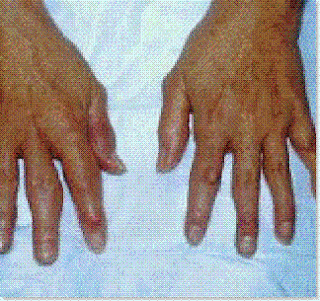loading...
 Rheumatoid arthritis is an autoimmune disease that causes inflammation in your joints. In RA, for reasons no one fully understands, the immune system – which is designed to protect our health by attacking foreign cells such as viruses and bacteria – instead attacks the body’s own tissues, specifically the synovium, a thin membrane that lines the joints.
Rheumatoid arthritis is an autoimmune disease that causes inflammation in your joints. In RA, for reasons no one fully understands, the immune system – which is designed to protect our health by attacking foreign cells such as viruses and bacteria – instead attacks the body’s own tissues, specifically the synovium, a thin membrane that lines the joints.
The cause of rheumatoid arthritis is not yet known. Most scientists agree that a combination of genetic and environmental factors is responsible. Researchers have identified genetic markers that cause a tenfold greater probability of developing rheumatoid arthritis.
Common symptoms of rheumatoid arthritis include:
- painful, swollen joints
- stiffness
- tiredness (fatigue), depression and irritability
- anaemia
- flu-like symptoms, such as feeling generally ill, feeling hot and sweating.
Less common symptoms include:
- weight loss
- eye inflammation
- rheumatoid nodules
- inflammation of other parts of your body.
Because the exact cause of Rheumatoid Arthritis is unknown, there is no causative treatment that can cure this disease. It should really be explained to the patient so that the treatment given out aimed at reducing complaints / symptoms of slowing progression of the disease.
The main objective of the program management / treatment is as follows:
- To relieve pain and inflammation.
- To maintain joint function and a maximum capacity of patients.
- To prevent and or correct deformity that occurs in the joints.
- Maintaining independence so as not to depend on others.
Management / Treatment of patients with Rheumatoid Arthritis, as follows:
1. Education
Adequate education about the disease to patients, their families and anyone connected with patients. Education will include understanding the pathophysiology (disease progression), the cause and estimated travel (prognosis) of the disease, all components of the program including the management of complex drug regimens, aid resources to cope with the disease and effective method of management provided by the health care team . The education process should be carried out continuously.
2. Rest - Sleep
Are important, because rheumatic usually accompanied by severe fatigue. Although fatigue can arise every day, but there was a time when people feel better or heavier. Patients should be split into several times a day time activity time followed by a period of rest.
3. Physical Exercise and Termoterapia
Specific exercises can be beneficial in maintaining joint function. This exercise includes active and passive movements at all joints pain, at least twice a day. Medication for pain relief should be given before starting the exercise. Hot compresses on the sore and swollen joints may reduce pain. Paraffin bath with adjustable temperature and bath with hot and cold temperatures can be done at home. Exercise and termoterapia is best regulated by the health workers who have received special training, such as a physical therapist or occupational therapist. Excessive exercise can damage the supporting structure of the joints that are already weakened by a disease.
4. Diet / Nutrition
Rheumatic Patients do not require a special diet. There are a number of ways giving a diet with a variety of diverse, but all unsubstantiated. The general principle to obtain a balanced diet is important.
5. Drugs
Medications are an important part of the whole program rheumatic disease management. The drugs are used to reduce pain, relieve inflammation and to try to change the course of the disease.